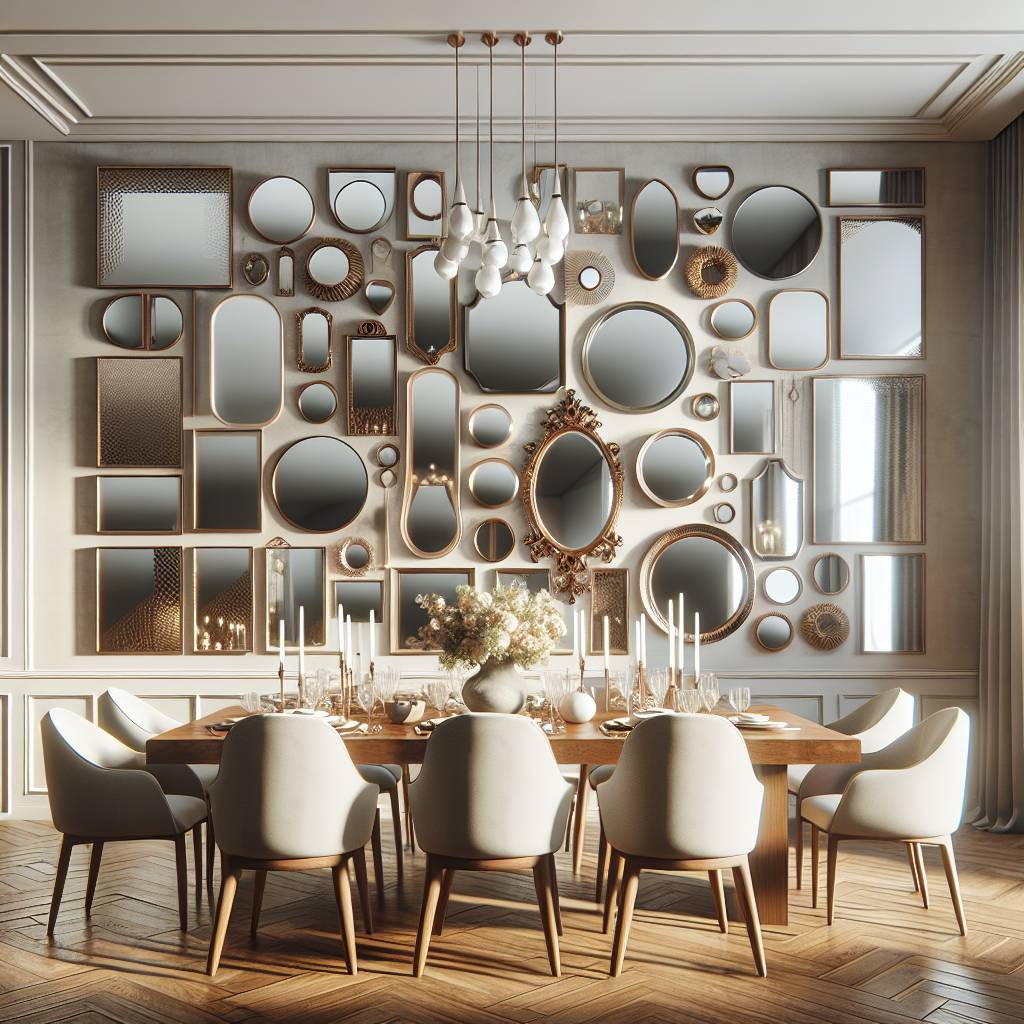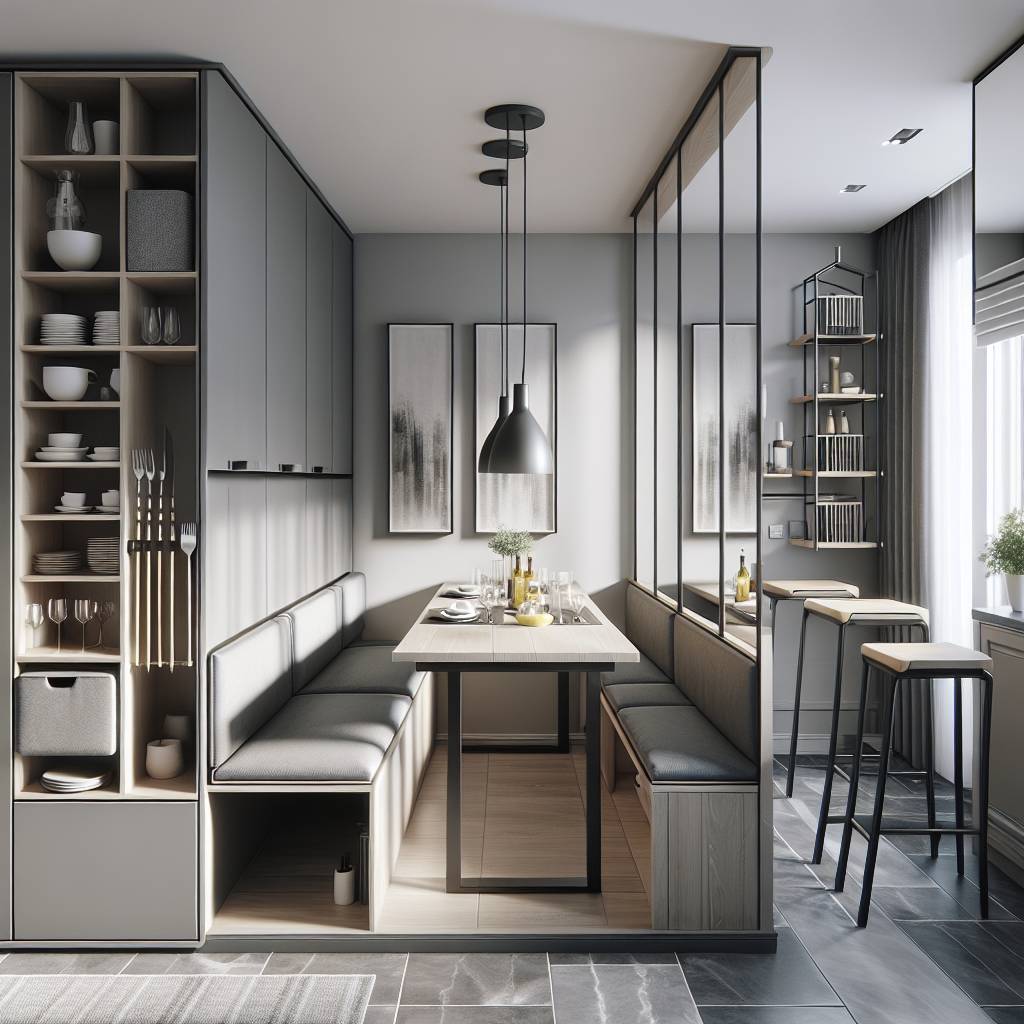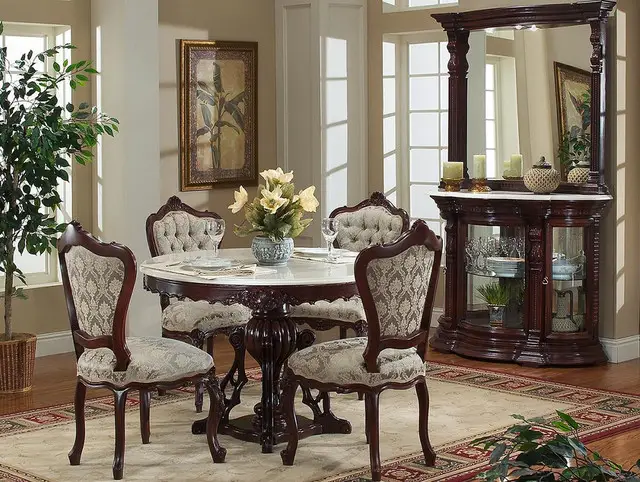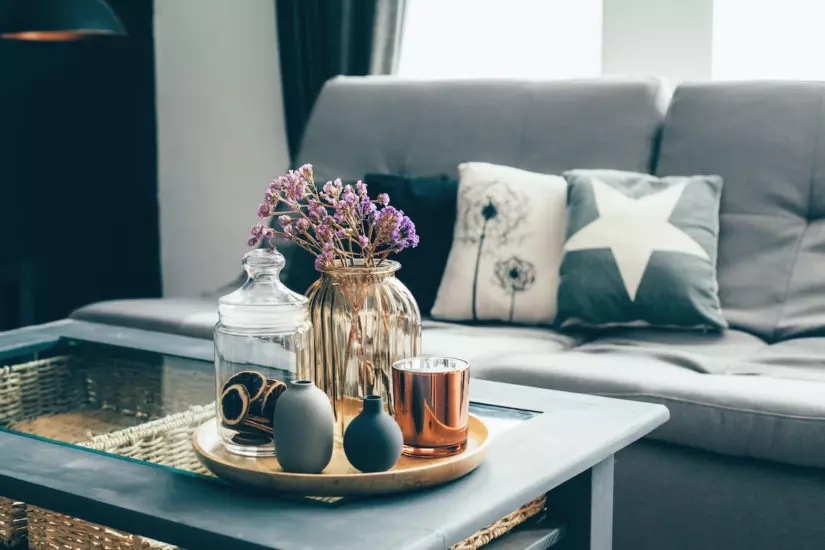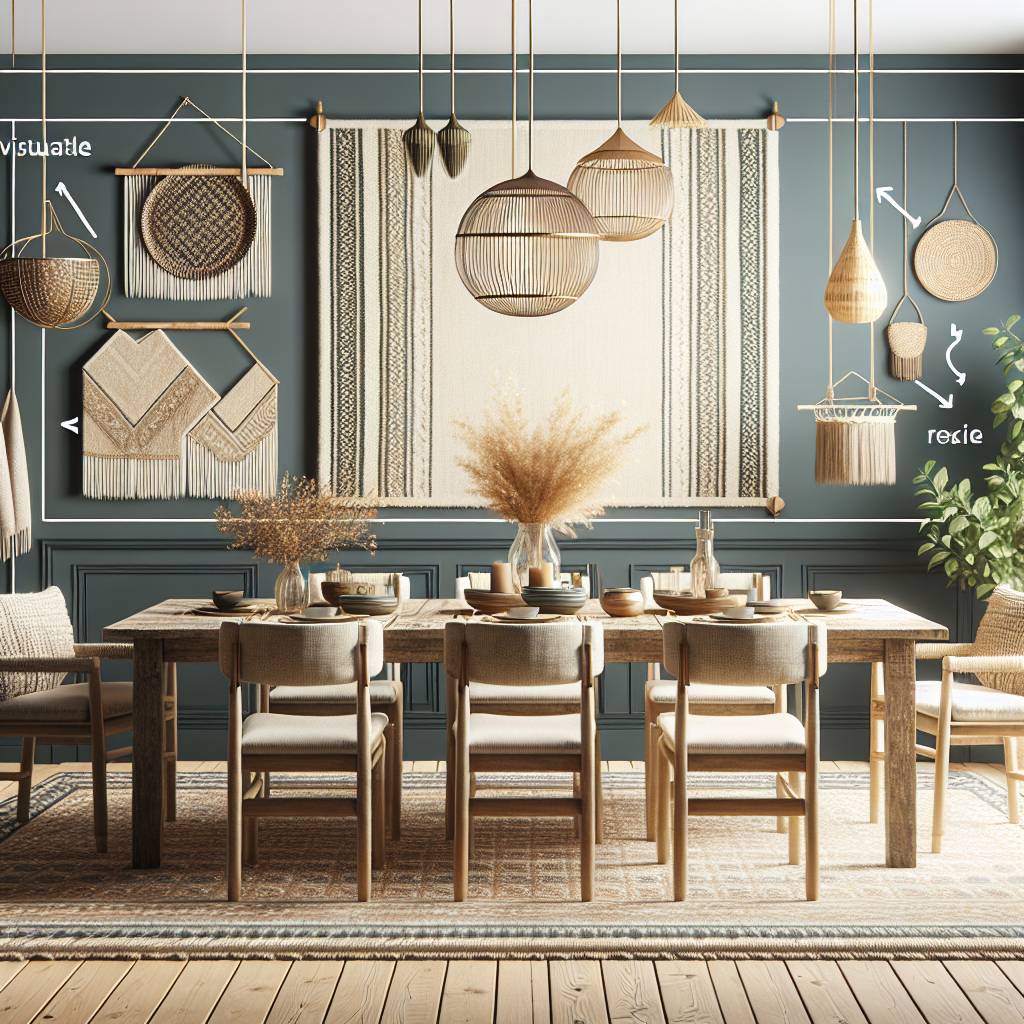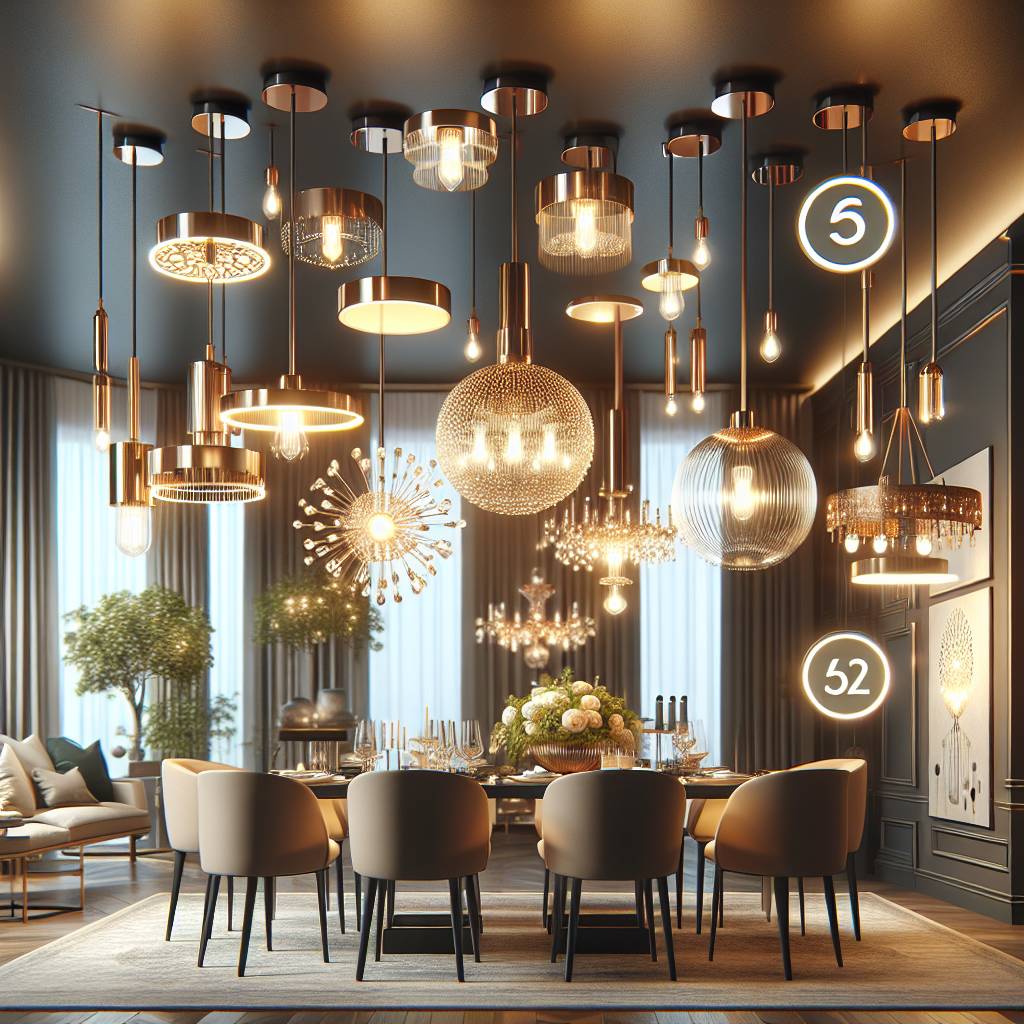Did you know that mirrors can transform a dining room, making it feel more spacious and elegant? When strategically placed, mirrors have the power to amplify light and create an illusion of depth, adding a touch of sophistication to your dining space. Imagine enjoying your meals in a small space that feels larger and brighter without any major renovations. By incorporating mirrors into your dining room decor, you can achieve just that. In this post, we’ll explore creative ways to use mirrors effectively on dining room walls, from enhancing natural light to creating captivating visual effects.
Key Takeaways
- Strategic placement of mirrors in dining rooms can create the illusion of more space and light, enhancing the overall ambiance.
- When choosing a mirror, consider the size, shape, and frame style to complement the dining room decor and reflect natural or artificial light effectively.
- Experiment with creative mirror ideas such as using multiple mirrors, decorative frames, or mirrored panels to add visual interest to dining room walls.
- Combining functionality with style by using mirrored furniture or incorporating mirrors into storage units can serve practical purposes while elevating the room’s aesthetic.
- Small mirrors can have a significant impact when arranged thoughtfully, contributing to a sense of depth and dimension in a dining area.
- Avoid common decorating mistakes by ensuring that mirrors are not placed directly opposite each other and considering the reflections they will create.
- Harmonize mirrors with the room decor by choosing mirrors that complement the style and color scheme of the dining area.
- Special considerations for small dining areas include using oversized mirrors to create the illusion of a larger space and being mindful of clutter or overcrowding reflections.
The Magic of Mirrors in Dining Rooms
Brightening Spaces
Mirrors have the remarkable ability to make a dining room feel more spacious and open. By reflecting light, mirrors can help brighten up a dimly lit dining area, creating an inviting atmosphere. Placing mirrors strategically on walls opposite windows or light sources can amplify the natural light, making the space feel airier.
For example, if your dining room has limited natural light, positioning a large mirror across from a window can effectively bounce and distribute the incoming sunlight throughout the room. This not only brightens up the space but also creates an illusion of additional square footage.
Creating Illusions
Strategic placement of mirrors in a dining room can create an illusion of a larger space. When positioned correctly, mirrors reflect both natural and artificial light sources, making the entire area appear more expansive than it actually is. Using mirrors cleverly can give the impression of depth in a dining area that may otherwise seem cramped.
For instance, placing multiple smaller mirrors along one wall or creating a gallery wall with various sized mirrors can visually elongate the room and add depth to its appearance.
Enhancing Aesthetics
The right choice of mirrors can significantly enhance the overall visual appeal of your dining room. Incorporating well-chosen mirrors into your decor adds elegance and sophistication to the space while contributing to elevating its aesthetic charm. Whether you opt for ornate frames or sleek modern designs, mirrored surfaces effortlessly blend with various interior styles.
By integrating decorative mirror panels or statement pieces above sideboards or buffets within your dining area’s design scheme, you elevate its style quotient while adding visual interest.
Maximizing Impact
Mirrors possess immense potential to make a significant impact on the ambiance of any dining area when used thoughtfully. Thoughtfully placed mirrors maximize their visual impact by accentuating key design elements within your dining space while amplifying its overall allure.
Consider incorporating oversized floor-to-ceiling mirrors behind your dining table to create an impactful focal point that reflects not only diners but also visually expands upon surrounding decor elements such as lighting fixtures and artwork.
Choosing the Perfect Mirror
Size and Proportion
When enhancing dining room walls with mirrors, it’s vital to consider the size and proportion of the mirrors in relation to the room’s dimensions. Appropriately sized mirrors are crucial for maintaining balance in the dining area. For instance, a small mirror might get lost on a large wall, while an oversized mirror could overwhelm a smaller space.
The proportion of mirrors should complement the scale of the dining room. A good rule of thumb is to ensure that there is enough wall space around and above the mirror so that it doesn’t look cramped or out of place. This creates visual harmony within the space.
For example:
- In a smaller dining room, one large mirror can make it feel more spacious.
- In a larger dining room, several smaller mirrors arranged together can create an interesting focal point without overpowering the space.
Shape Variations
Exploring different mirror shapes such as round, rectangular, or oval can add varied visual interest to your dining room decor. Mixing various mirror shapes brings dynamism into play by breaking up straight lines or adding curves where needed.
Incorporating diverse mirror shapes also introduces an element of creativity into your dining space. For example:
- A mix of round and rectangular mirrors can create an eclectic yet balanced look.
- Using uniquely shaped mirrors like sunburst or irregularly shaped ones adds character and uniqueness to your design scheme.
Frame Styles
Selecting different frame styles for your chosen mirrors allows for versatile design possibilities within your dining area. The frame style plays a significant role in influencing the overall aesthetic theme of your dining room decor.
Matching or contrasting frame styles can create distinct visual impacts in this part of your home. For instance:
- Ornate frames bring elegance and sophistication.
- Minimalist frames offer simplicity and modernity.
Color Harmony
It’s essential to consider coordinating mirror frames with existing color schemes when integrating them into your dining room walls. Mirrors with frames that complement or contrast with wall colors enhance visual appeal through color harmony.
Achieving color harmony between mirror frames and surrounding decor promotes cohesive design within this part of your home:
For example:
- Matching metallic frames with other metallic accents (like light fixtures) ties everything together.
- Contrasting dark-colored frames against lighter walls adds depth while creating eye-catching contrast.
Strategic Placement for Maximum Effect
Wall Positioning
Strategic positioning of mirrors on dining room walls is crucial to maximize their reflective properties. Careful consideration of wall placement ensures that mirrors serve their purpose optimally, creating a visually appealing and spacious ambiance. Placing mirrors opposite windows or light sources can help bounce natural or artificial light around the room, making it feel brighter and more open. For example, a mirror positioned across from a window can reflect outdoor scenery into the dining space, bringing an element of nature indoors.
Proper wall positioning plays a key role in maximizing the impact of mirrors in a dining room. Placing mirrors at eye level or slightly above eye level allows them to reflect more of the room and create an illusion of depth. This technique is particularly effective in smaller dining areas where creating a sense of spaciousness is essential.
Reflecting Light
Mirrors strategically positioned to reflect natural light can significantly brighten up a dining space, creating an inviting and cheerful atmosphere without relying solely on artificial lighting. By reflecting sunlight into darker corners or areas with limited direct light exposure, well-placed mirrors contribute to an illuminated ambiance throughout the day.
Utilizing mirrors to reflect artificial lighting sources also enhances the overall luminosity in a dining room during evening gatherings or dinner parties. Placing mirrors near lamps, chandeliers, or sconces amplifies their glow and spreads warmth evenly across the entire space.
When considering mirror placement for reflecting light, it’s important to avoid directing glare directly toward seating areas as this may cause discomfort for diners.
Creative Mirror Ideas for Dining Walls
Incorporating geometric patterns can significantly elevate the visual appeal of the space. By strategically placing mirrors with geometric shapes such as hexagons, diamonds, or overlapping squares on the dining room walls, an intriguing and dynamic effect can be achieved. These patterns not only add a modern and stylish touch but also create an illusion of depth and dimension within the room.
The use of geometric patterns in mirrors for dining room walls offers a versatile way to play with light and shadow. For instance, by arranging hexagonal mirrors in a honeycomb pattern, one can introduce a contemporary yet elegant aesthetic that complements various interior design styles. The interplay between light and shadow created by these geometric shapes adds an element of visual interest while enhancing the overall ambiance of the dining area.
In addition to their aesthetic appeal, geometric patterned mirrors contribute to creating an open and spacious feel within the dining space. Placing them strategically can visually expand the perceived size of the room by reflecting both natural and artificial light sources throughout the area. This approach is especially beneficial for smaller dining rooms or those with limited natural light, as it helps brighten up the space while adding a touch of modern sophistication.
Utilizing vintage elegance in conjunction with geometric patterns allows for blending classic charm with contemporary flair within your dining area’s decor. Incorporating ornate frames around these sleekly shaped mirrors creates a captivating juxtaposition that exudes timeless beauty while infusing a sense of modernity into your space.
Combining Functionality with Style
Mirror Backsplashes
Enhancing dining room walls with mirrors can involve using them as backsplashes, creating a sense of depth and openness. By installing mirror backsplashes, you can make the dining area appear more spacious and bright. The reflective surface also adds an elegant touch to the space, making it feel more luxurious.
Mirrors used as backsplashes are not only visually appealing but also serve a practical purpose by protecting the wall from food splatters and stains. This dual functionality makes them an ideal choice for both style and maintenance. They can be easily cleaned with a simple wipe-down, ensuring that your dining area always looks pristine.
Cohesive Pairings
When incorporating mirrors to enhance dining room walls, consider cohesive pairings such as combining them with artwork or other decorative elements. For instance, placing a large mirror alongside framed artwork creates an interesting juxtaposition of textures while adding visual interest to the space.
Another way to achieve cohesive pairings is by strategically positioning mirrors near light sources like windows or lamps to maximize their reflective properties. This not only amplifies natural or artificial light in the room but also creates captivating patterns and plays of light on adjacent surfaces.
Statement Pieces
Using mirrors as statement pieces in dining rooms can transform the entire ambiance of the space. Large ornate mirrors or uniquely shaped ones become focal points that draw attention and add character to the room’s decor. These statement pieces not only reflect light but also create stunning visual effects that elevate the overall aesthetic appeal.
In addition to their decorative function, statement mirrors have practical benefits too; they contribute to creating an illusion of grandeur by making small spaces seem larger than they actually are. Furthermore, when strategically placed opposite striking features like chandeliers or architectural details, these statement pieces enrich the visual dynamics of the dining area.
Small Mirrors, Big Impact
Visual Tricks
Placing small mirrors strategically on dining room walls can create an illusion of more space. The reflection of the room in the mirrors makes it seem larger and more open. This is especially effective in smaller dining areas where space might be limited. By reflecting light around the room, small mirrors can also make the space feel brighter and more inviting.
The placement of these mirrors is crucial for achieving the desired effect. Placing them opposite a window or a source of light will maximize their ability to reflect light and visually expand the space. Using multiple small mirrors instead of one large mirror can add depth and dimension to the wall, creating an interesting visual display.
Complementary Accents
Incorporating complementary accents alongside small mirrors can further enhance their impact on dining room walls. For example, decorating around the mirrors with artwork or decorative sconces can draw attention to them while adding personality to the overall design scheme. This combination creates a balanced look that elevates both the individual elements and the entire wall.
Another way to amplify this effect is by framing each mirror with distinctive frames that complement other decor elements in your dining area. This adds texture and visual interest while tying together different design components within your space.
To illustrate, consider placing two sets of three small circular mirrors on either side of a large piece of artwork or a decorative accent like a clock or sculpture mounted on your dining room wall. The arrangement not only creates symmetry but also draws attention to both sets of items simultaneously, making them stand out even more.
Avoiding Common Decorating Mistakes
Overcrowding Walls
When using mirrors to enhance dining room walls, it’s crucial to avoid overcrowding. Placing too many mirrors on a single wall can create a cluttered and chaotic look. Instead, opt for strategically positioning a few statement mirrors that complement the space without overwhelming it. For example, consider placing one large decorative mirror as the focal point and surrounding it with smaller matching mirrors or artwork to create an aesthetically pleasing arrangement.
Overcrowding can lead to visual confusion and make the dining area feel cramped. It’s essential to leave enough breathing room between each mirror, ensuring they don’t compete for attention but rather work together harmoniously. By carefully curating the placement of mirrors, you can achieve an elegant and balanced look that enhances the overall ambiance of the dining room.
Mismatched Styles
Another common mistake when enhancing dining room walls with mirrors is incorporating mismatched styles. While mixing different design elements can be appealing in some contexts, using disparate mirror styles in close proximity might result in a disjointed appearance. To maintain cohesiveness, aim for consistency in frame materials, shapes, or themes across your chosen mirrors.
For instance, if you have a modern minimalist dining room decor theme, select sleek and simple framed mirrors that align with this aesthetic. Conversely, if your style leans more towards traditional or ornate designs, opt for decorative frames with intricate details that complement the existing decor scheme. By ensuring uniformity in mirror styles while still allowing individuality within each piece, you’ll achieve a polished and unified look on your dining room walls.
Inadequate Lighting
Incorporating mirrors into dining room wall decor without considering lighting requirements is another misstep to avoid. Insufficient lighting around mirrors can diminish their impact and fail to maximize their reflective properties effectively. To address this issue, strategically position light sources such as lamps or overhead fixtures near your chosen mirrored areas.
Harmonizing Mirrors with Room Decor
Matching Wallpaper
When using mirrors to enhance dining room walls, consider matching them with the wallpaper. If the wallpaper has a bold pattern or vibrant color, opt for mirrors with simple frames to avoid overwhelming the space. On the other hand, if the wallpaper is more subtle, you can choose mirrors with intricate designs or decorative frames to add visual interest.
For example, if your dining room features floral-patterned wallpaper in soft pastel tones, complement it by hanging mirrors with delicate gold frames. This creates a cohesive and harmonious look that doesn’t compete with the existing decor.
Another approach is using mirrored tiles as an alternative to traditional wall-mounted mirrors when coordinating with patterned or textured wallpapers. The reflective surface of these tiles adds depth and dimension while seamlessly blending into various design schemes without clashing.
Coordinating Furniture
Using mirrors on dining room walls also involves coordinating them with existing furniture. Ensure that the size and style of your mirror complement your dining table and chairs rather than overpowering them. For instance, if you have a sleek modern dining set, consider using minimalist frameless mirrors or those framed in metal for a contemporary touch.
On the other hand, if your dining area features classic wooden furniture, ornate framed mirrors can elevate the traditional aesthetic while adding an element of sophistication. Aim for balance by choosing mirror sizes proportional to nearby furnishings; oversized mirrors might overwhelm smaller tables whereas smaller ones may get lost above larger pieces.
To create an illusion of spaciousness within compact dining areas or enhance natural light distribution from windows during daytime meals, position strategically-sized mirrors across from light sources such as chandeliers or windows. This not only brightens up space but also makes it feel more open and airy.
Accessorizing Smartly
Incorporating mirrors into your dining room decor requires smart accessorizing around these reflective surfaces. Utilize complementary accessories like wall sconces flanking either side of large vertical rectangular-shaped mirror panels to amplify their impact within this social setting.
Consider placing decorative items such as candle holders or artwork strategically near horizontally-oriented circular or oval-shaped accent mirrors, drawing attention towards specific focal points in this communal space while simultaneously infusing character into its design scheme.
Strategically placed greenery near floor-length leaning mirrors introduces organic elements which help soften harsh lines while bringing nature indoors effectively enhancing visual appeal within this vital living space.
Special Considerations for Small Dining Areas
Space-Enhancing Tips
There are several tips to consider. Firstly, strategically placing mirrors can create an illusion of a larger dining area. Placing a large mirror on one wall can reflect the entire room, making it appear more spacious and open.
Another tip is to use multiple smaller mirrors instead of one large mirror. By arranging them creatively on the walls, they can create interesting reflections and add depth to the room without overwhelming the dining space. Using mirrored furniture such as sideboards or cabinets can also enhance the perception of space while providing functional storage solutions.
Moreover, incorporating mirrors into decorative elements like framed mirror panels or mirrored tiles can contribute to visually expanding the small space. These decorative pieces not only serve as reflective surfaces but also add an aesthetic appeal to the dining area.
Closing Thoughts
You’ve now unlocked the secrets to using mirrors to enhance your dining room walls. From choosing the perfect mirror to strategically placing it for maximum effect, you’ve learned how to harmonize functionality with style and avoid common decorating mistakes. Whether you have a small or large dining area, these creative mirror ideas can make a big impact, transforming your space into a captivating and inviting setting for memorable meals.
Now it’s your turn to put these insights into action. Take the time to assess your dining room and consider how you can incorporate mirrors to elevate its ambiance. Experiment with different sizes, shapes, and placements to find what works best for your space. By doing so, you’ll not only add visual interest but also create an illusion of spaciousness and light that will impress your guests and enhance your overall dining experience.
Frequently Asked Questions
How can mirrors enhance the dining room walls?
Mirrors can create an illusion of space, reflect natural light, and add depth to the dining area. They also serve as decorative elements that can amplify the ambiance and style of the room.
What are some common decorating mistakes to avoid when using mirrors in dining rooms?
Avoid placing mirrors directly opposite each other, as it may result in a disorienting effect. Also, refrain from using oversized mirrors in small dining areas, which might overwhelm the space.
Are there specific considerations for incorporating mirrors into small dining areas?
In smaller spaces, opt for smaller or strategically placed mirrors to avoid overwhelming the area. Consider utilizing mirrored furniture or decor pieces to achieve a sense of spaciousness without overcrowding the room with large reflective surfaces.
How do I harmonize mirrors with my existing dining room decor?
Select mirror designs that complement your current decor theme. For example, if your style is modern and minimalist, choose sleek and simple mirror frames that align with this aesthetic. This ensures a cohesive look throughout your dining space.
Can you combine functionality with style when using mirrors in a dining room setting?
Absolutely! Mirrors not only enhance visual appeal but also contribute functionally by reflecting light and creating an inviting atmosphere. Choosing stylish yet practical mirror designs allows you to achieve both aesthetic beauty and practicality within your dining area.
